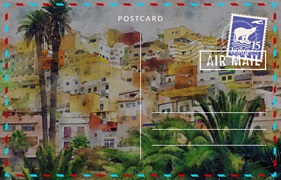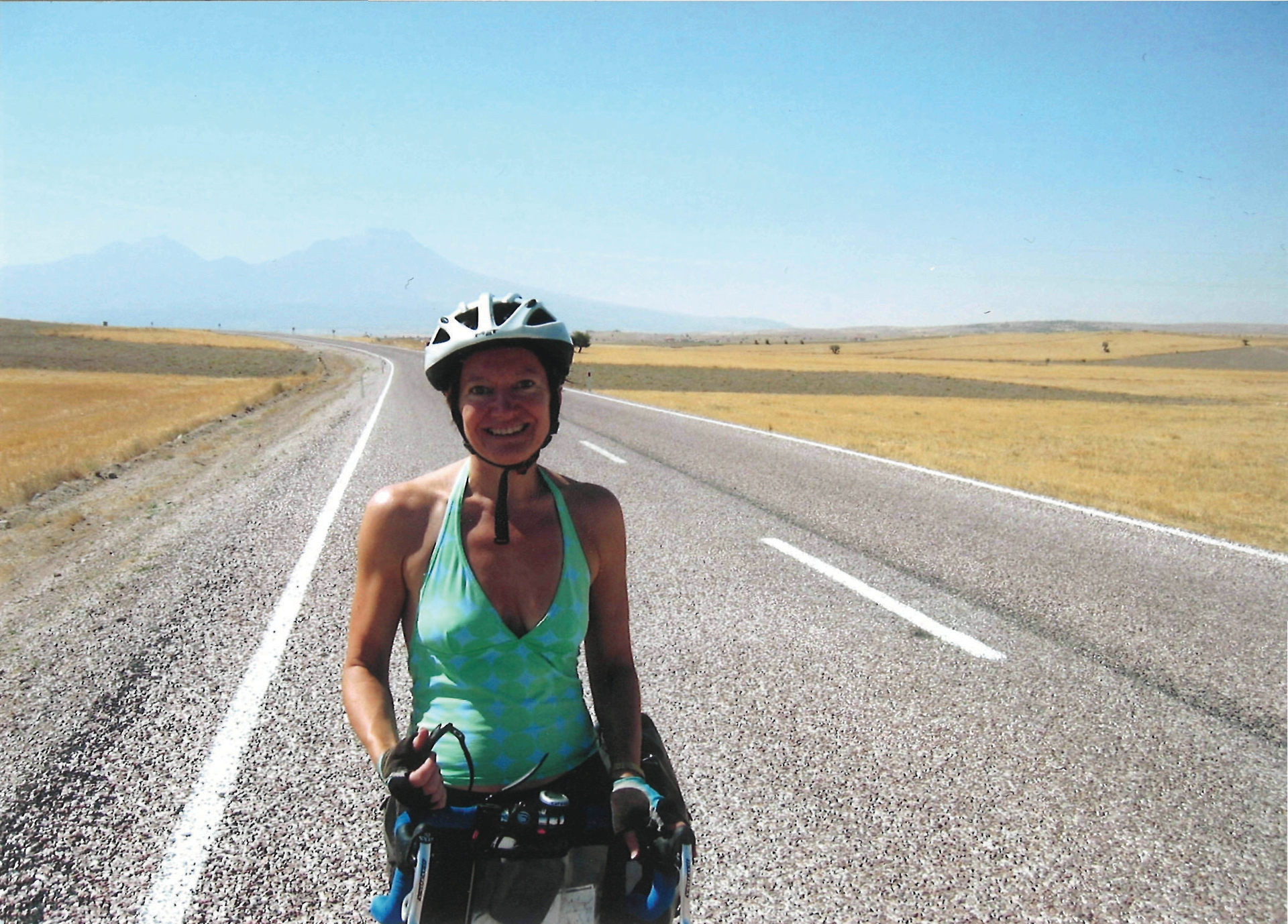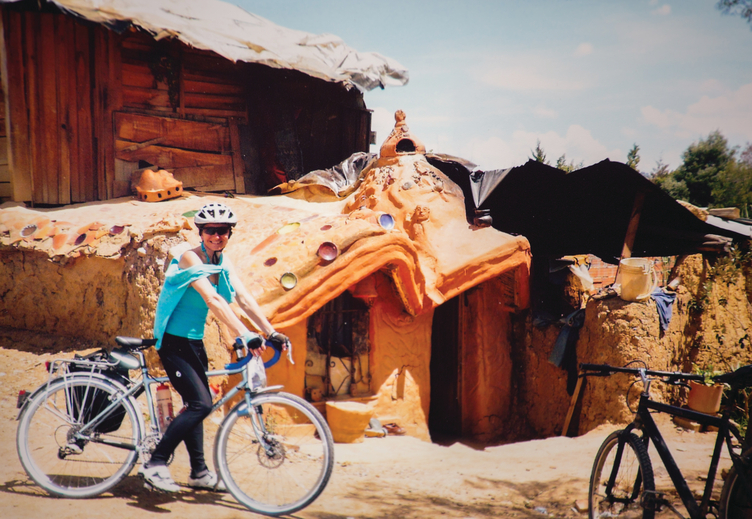
In search of joy
Say it in a postcard | Issue 20 | 2022


—Enter the world of cycle touring with Miriam Davies—
I have always ridden a bike but I only started cycle touring about twelve years ago and I am 54 now. Every year, my partner and I put our bikes on a train or a ferry or we box them up to go on a plane, and we set off to see another part of the world. We do this as often as we can; Alex has seventeen bikes and I have three, so I suppose we qualify as passionate cycle geeks. We are not mountain bikers or bike-packers, we don’t do the great crowded cycle rides, and we don’t race: we like to enjoy the journey.
I have joined in with the traditional Sunday sweep of cyclists—ciclovía—in Colombia. I have enjoyed chic city cycling in Copenhagen. I have skirted wild pigs darting across the road as we descended hills in Corsica. I have foraged for blueberries in Sweden, frozen in the intense cold of Shangri-la, and encountered Gaelic music and fierce Jack Russell dogs in Ireland. I have slept in treehouses in Brittany, cave hotels in Turkey, houseboats in Kerala—and endless tents. I have cycled the Buddhist pilgrimage trail around Shikoku, along cobbled streets in France, through sleepy villages in Chile and up and down every quiet road the length of my own country.
You only need one bike and one companion. The bike you can hire, the companionship you will find when you join a group. You don’t even need a tent. There is no requirement to be a cycle geek.
Factors including weather, terrain, traffic, political stability and the location of friends and family outside the UK all influence our decision on where to go. Food also provides a strong pull. Cycling in the hills outside Kalamata, we lunched on calamari and salty feta, succulent tomatoes and the freshest bread. We enjoyed meze in Turkey, grilled fish in Sri Lanka and Sweden, delicate coconut fish curries in Kerala and tam mak hung (papaya salad) in Laos.
Kindness and generosity have been shown to us on so many trips. In Turkey, we received constant invitations to share mint tea on the carpet outside homes around Cappadocia. In Uruguay, when my bike fork snapped, men in a rundown garage immediately helped by welding and re-spraying the fork—and then refused any payment. On the island of Shikoku, an elderly gardener bowed and presented me with a marigold plant in a blue ceramic pot, which, for the rest of our tour, remained like a mascot in my map case at the front of my bike.
We have done a lot of camping, chiefly in Europe, and I have many a blissful tale of cooking our food in the open air and of camping wild. It is an extraordinary pleasure to not be constrained by time. I also have a few mishaps/challenges to relate, including camping in a midge-infested Scottish glen. If camping is not your thing, that need not stop you from planning a cycling tour: just leave the tent at home.
The joy of cycle touring is the sense of freedom it brings, so don’t fret or try to control too much. Among other things, watch out for traffic, be on the alert for local dogs and keep an eye on the weather.
There are three types of cycle tour and all are fabulous.
Guided | You pay to be led along a pre-defined route by a guide and your luggage is transported to the accommodation they select. There is usually the option of hiring a bike. A back-up vehicle is provided, so if you’re cycling in torrential rain or feeling fragile you can take a rest.
Self-guided | The route, accommodation and meals are taken care of by the company. You just need to navigate a pre-defined course without a guide. There’s often the option to have your luggage transported.
Independent | You travel your chosen route without a guide, carry everything you need and find your own accommodation—or you camp.
Budget | Independent cycle touring opens up the possibility of big adventures on a surprisingly small budget. The greatest expense is usually the flight or ferry. In many countries, £50 per day on food and accommodation for two people is plenty.
The real investment is the bike. In the UK, you can expect to pay around £1000 for a decent touring bike and up to £2000 for bespoke models. Bear in mind that this could last you for ever, and that you can use a touring bike for every purpose imaginable, from commuting to off-road.
Hiring a bike is another option and one I have done many times and can wholeheartedly recommend. The bikes available on guided tours are high-spec and just right for the job.
Type of bike | For trips of a week or more, if you intend carrying your own luggage, I recommend a touring bike. Touring bikes have wider tyres than road bikes and are made of steel (or titanium), enabling them to support more weight and ride in rougher conditions. Many have very low gears, so you will have an easier time climbing hills or mountains while carrying a heavy load. They are also built to support racks on the front and back, allowing you to carry up to four panniers. And they are designed to keep you comfortable for far longer than road bikes.
My bike is an 18-inch Roberts Rough Stuff Lite with 26-inch wheels. Made to measure (ten years ago), it’s my most adored possession!
Logistics | When Alex and I started cycling together, I enjoyed the security of planning the route and booking accommodation in advance. But we soon preferred to plot a route outline on a GPS without committing ahead to accommodation. This approach enabled us to take up the suggestion of staying with a family in the hills above Karsiyaka in western Turkey. A conversation with cyclists as we travelled west along Sri Lanka’s south coast led us to the idyllic Mangrove beach near Tangalle. The previous week, we had accepted an invitation to stay in a tea plantation supervisor’s bungalow. Keeping things open also means that rest days and recovery/ repair days can be fitted in. Of course, we plan our itinerary around flight times and ferry departures.
We aim to cycle 50 miles (80km) a day but the weather, terrain and places of interest (including food and water stops) all decide how long that will actually take. On some days we finish 50 miles by lunchtime; on others we finish much later. In Colombia, a route which appeared to be tarmac on the map proved to be very rough ground, causing Alex’s tyre to come apart. In Thailand, a 7am start to avoid the intense heat worked well and meant we could spend each afternoon on the beach.
Knowledge of the language certainly adds flavour but I have been able to get by on just a few phrases.
Fitness | Our cycle touring trips are not feats of physical endurance. Moderate fitness, a little prior cycle experience plus a comfortable saddle (or padded shorts) will increase your enjoyment. The main requirement is taking pleasure from the sight of spectacular landscapes; the desire to explore will be enough to generate momentum.
Links | There are so many companies and individuals out there. Try cycle blogs and word-of-mouth recommendations.
France | Ferry to Ouistrehem/Caen–cycle voie vert
Scotland | Glasgow to Ardrossan—ferry to Arran—cycle Brodick, Lochranza, Lochgilphead, Oban, Tobermory (Mull), Mallaig, Broadford (Skye), Portree, back to Glasgow via Mallaig
Sweden | Skavsta airport—cycle through nature reserve to Sund Nergården Vagnhärad (hot tub overlooking lake)—hotel in Stockholm—explore city by bike—B&B at Mälby Säteri Gnesta—final night close to airport
Turkey | Cappadocia—fly to Kayseri—cycle Urgup, Uchisar, Urgup, Goreme, Nevsehir, Soganli, the Ihlara Valley, Guzelyurt, Derinkuyu, Urgup
Uruguay | Montevideo to Canelones—El Galope hostel—Colonia del Sacramento—Carmelo—Mercedes—Canelones— Montevideo
Ireland | Cork to Baltimore (ferry to Cape Clear Island), Baltimore—Dromloc, Glengarrif (via Beara peninsula)—Tralee—Dingle peninsula—Portmagee—Coolea—Cork
Sri Lanka | Sigirya to Dambulla (climb Sirirya rock)—Polunnaruwa—Kandy—Nurawa Eliya—Ella—Tissamaharama—Bundala National Park—Galle—Colombo
Colombia | Bogotá, Zipaquira (salt cathedral)—Villa de Leyva (casa de barro y observatorio)—Tunja
Greece | Peloponnese: Kalamata—Korone—Methone—Dimitsana—Mystras
Cycle equipment | Allen keys, multi-tool, Bike lights, Brake cables, Inner tubes, Panniers (Ortlieb, waterproof), Plastic tyre levers, Pump, Puncture repair kit, Spare tyre, Spokes
Cycle clothes | Cycle gloves, Cycle helmet, Cycle shoes (cleats), Shorts, Tops (Lulu Lemon), Water bottles, Waterproof
Other clothes | Dress (lycra), Sarong/scarf, Sandals, Swimming costume, Top, Trousers
Miscellaneous | Camera, Dog dazer, Head torch, Insect repellent, Phone charger, Silk liner, Sun glasses, Travel towel, Washing line
Our abiding memory of our trip to Laos is of people’s kindness. Smiles followed us everywhere we went. As we left Van Vieng, children on the way to school took great delight in cycling alongside us, and near Luang Prabang young monks on bikes joined us, too. We visited a village school in Ban Nalay where the children’s effervescent enthusiasm was equal to the respect they showed their teachers. The village had no running water or electricity but we felt privileged to stay the night—to bathe in the river and enjoy their local brew.
It was December, and when we cycled out from Valencia onto the via verde, everything was bathed in sunshine. The next day, as we headed west, uphill, the sun was still shining. A few hours later we were pushing our bicycles through snow, pausing to clear packed snow from beneath mudguards. At the top of the 1000-metre ridge a rough track replaced tarmac, and it became even more difficult to cycle. Dark came quickly and the temperature fell. We were new to GPS navigation and had misread the scale. In a surprisingly short time, the situation changed from being an amusing challenge to a more serious concern about where we would spend the night. The GPS displayed only uninhabited forest and a track skirting huge, deep valleys. A few hours later, we saw a small cluster of lights. Much later, we climbed the cobbled streets of La Pobleta and stopped at a bar. Elderly men, huddled around a log fire, looked surprised to see us. The innkeeper explained in Spanish that they had no rooms: we would have to cycle 21 kilometres to the nearest hotel—but then her husband offered us the use of their storeroom. He found us a mattress and a blanket and we slept wearing our hats, gloves and most of our cycle clothes. We always carry an electric heating element, so we made hot chocolate and reflected on the day. In the morning, the owner refused to take any money and gave us a jar of honey from his beehives.
I love the chain of islands that make up the Outer Hebrides. Freshwater lochs, sandy Atlantic shores, flower-rich machair meadows and soft rain—no wonder the Hebridean Islands produce incredible food. Our cycle route took us from Barra in the south through South Uist, Benbecula and Harris, up to the Isle of Lewis and back again. Along the way we savoured the sweetest crabs and scallops and superb flaky salmon. Wild camping on deserted beaches is one of the many joys of Scotland. Casting a line from the shore of one of South Uist’s alkaline lochs, we hoped for a fish supper. Local fishermen promised to share their catch if we had no luck—and, true to their word, we dined on the most divine mackerel that evening. I mentioned to a local woman that I was looking for marine algae to make Hebridean carrageen pudding. That afternoon, she kindly left freshly foraged carrageen outside our tent. I wrapped the red seaweed in muslin, put it in a pan of milk and let it simmer for half an hour, before sieving the mixture—once set, the pudding tasted like a delicate panna cotta.
2015
Uruguay (Jan)
Sweden (Aug)
Spain—east coast (Sep)
2014
Canary Islands—Lanzarote (Jan)
Turkey—Izmir (Apr)
France—Loire (Jun)
Spain—Asturias (Sep)
2013
Thailand (Mar)
Denmark—Copenhagen (May)
Greece—Kalamata (Aug)
2012
Sri Lanka (Mar)
Croatia—island hopping (Jun)
France—Bayonne to St Malo (Sep)
2011
China—Yunnan (Mar/Apr)
Scotland—Outer Hebrides (Aug)
2010
Morocco (Mar)
France—Canal du Midi (May/Jun)
Ireland—south coast, western peninsulas (Aug/Sep)
Tunisia—east coast to Djerber and back (Dec/Jan)
2009
Colombia (Mar)
Scotland—Arran, Mull, Skye (May/ Jun)
France—Brittany, Normandy (Sep)
UK—Newcastle to Edinburgh and Holy Island (Oct)
2008
Japan—Shikoku, Kyoto (Mar)
Ireland—Dublin, Kingfisher Trail (May)
France—Pyrenees (Aug)
Spain – Valencia (Dec)
2007
Laos (Feb)
Turkey—Cappadocia (Sep)
Spain—Andalusia, Jerez (Dec)
2006
Chile, Argentina (Feb)
Sardinia (Sep)
France—Montreuil (Dec)
2005
Southern India (Feb)
France—Corsica (Sep)

Photographs by Alex Stefanovic
© Norton Rose Fulbright LLP 2025